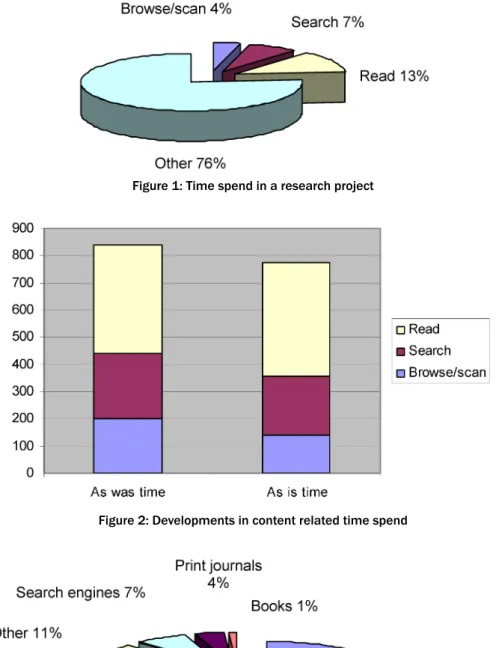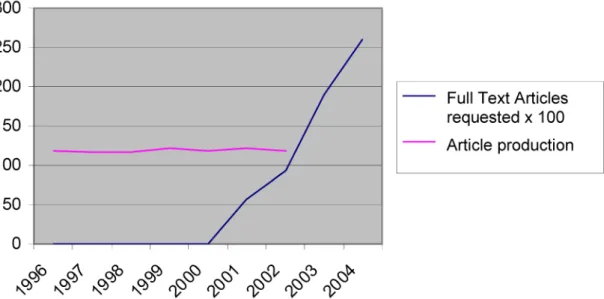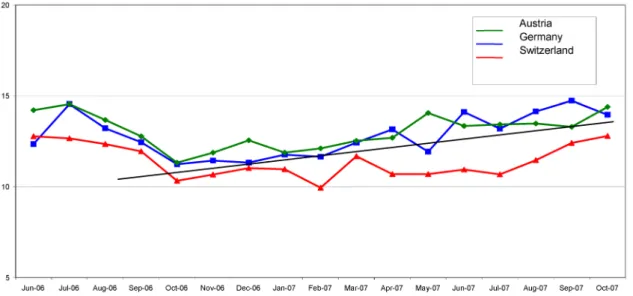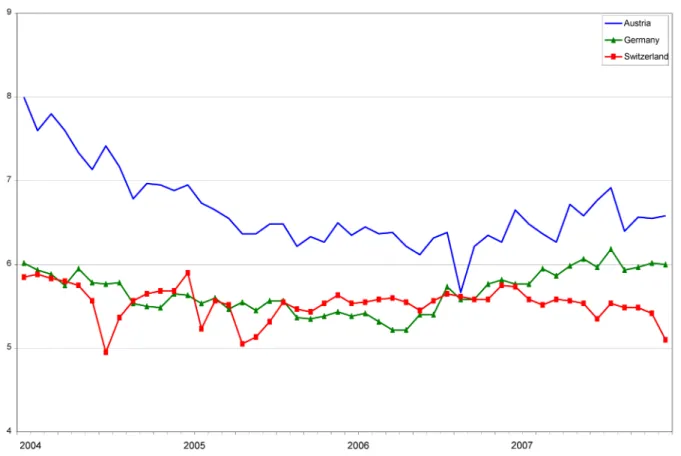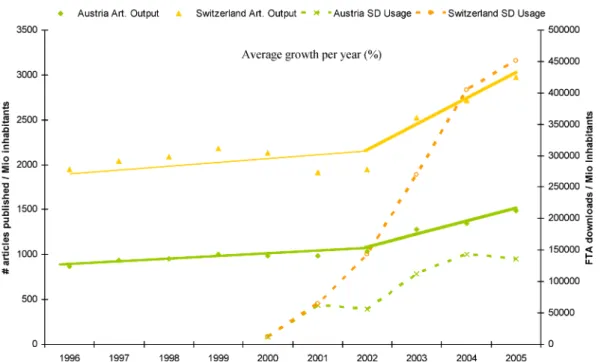Datenbankstatistiken angewandt zur Effekterforschung der
Informationsservice auf die Veröffentlichung akademischer Publikationen – eine vergleichende Studie Österreich, Deutschland und die Schweiz betreffend
Abstract
In this study, estimations of the effects of electronic information services on academic research as made in 2004, are confronted with the actual
Arthur Eger
1situation. For this purpose database statistics on session length per
1 Elsevier BV, Amsterdam, The Netherlands
user session, the role of “Referrers” and number of Full Text Articles requested per user session are analysed. The effect of a larger content offering is studied by analysing the relationship between subscribed titles and Full Text Articles requested. Finally a possible relationship between R&D spend, subscription spend and article publication is sought. This study found that time spent on Browse/scan and Search is increasing, possibly caused by a broader penetration amongst less trained users. This study further clearly showed that a larger content offering coincides with a dramatic increase in Full Text Article requests, and an increase in Full Text Article requests, after about 2 years, coin- cides with increased article publication.
Keywords:database statistics, larger content offering, increased article publication
Zusammenfassung
In dieser Studie wird die Schätzung der Auswirkungen, die die elektro- nischen Informationsdienste auf die Forschung hat, aus dem Jahr 2004 den tatsächlichen gegenüber gestellt. Dazu sind Datenbankstatistiken über die Dauer der Datenbanksuche, die Rolle von “Referrers“ und die Zahl der Volltextartikel pro Benutzerabschnitt analysiert worden. Der Effekt des größeren Inhaltsangebots wurde untersucht, indem man das Verhältnis zwischen abonnierten Titeln und gefragten Volltextartikeln analysierte. Schließlich ist gesucht nach einem Zusammenhang zwi- schen R&D-Ausgaben, Subskriptionsausgaben und der Anzahl der pu- blizierten Artikel. In dieser Studie hat sich herausgestellt, dass die Zeit, die mit Browser/Scan und Suche verbracht wird, zunimmt, möglicher- weise durch einen größeren Zugriff weniger datenbankgeschulter Be- nutzer. Außerdem zeigt diese Studie deutlich, dass ein größeres Inhalts- angebot gepaart geht mit einer drastischen Zunahme der Volltextarti- kelanträge und diese wiederum, nach ungefähr 2 Jahren, korrespondie- ren mit einer ebenso erhöhten Artikelpublikation.
Schlüsselwörter:Datenbankstatistiken, erweitertes Zeitschriftenangebot, erhöhte Artikelpublikation
Figure 1: Time spend in a research project
Figure 2: Developments in content related time spend
Figure 3: Time spend on various content types
Introduction
In an study by Elsevier, undertaken in 2004 in coopera- tion with the Biochemistry Department of the University of Utrecht in The Netherlands, participants were reques- ted to estimate the effects of electronic information ser- vices on academic research [1]. Participants estimated that content related activities account for about a quarter of all time spend in a research project, as given in Figure 1.
The participants in the study further estimated that at that time slightly less time was spent on content related activities in total, but that within the content related
activities, researchers spent significantly less time on Browse/scan (-/-30%) and on Search (-/-10%), and slightly more time on Read (+5%), as given in Figure 2.
Estimations were further that most time spend on Content was spent on eJournals, followed by Abstract & Indexing (A&I) databases, as shown in Figure 3.
A correlation between the number of Full Text Articles requested and article production could not be derived from this study: the amount of Full Text Articles requested grew in the period 2000 trough 2003 with about 100%
annually, whereas the average article production in the period 1996 trough 2002 increased with a modest 3%
annually as given in Figure 4.
Eger: Database statistics applied to investigate the effects ...
Figure 4: Full Text Articles requested and article production at Biochemistry Department of the University of Utrecht, The Netherlands
Aim of this study
Aim of this study is to confront the estimations as made in 2004 with actual measurements. First, this study is looking for evidence for the assumption that improved access leads to more reading. Following, this study is looking for evidence that a larger content offering is leading to more reading and finally, this study is looking for a possible correlation between increased reading and increased article production.
Methods
To get insight in the development of researcher’s time spending on content, Browse/scan and Search, an ana- lysis of the average session duration in the Abstract &
Citation database Scopus and in the Full Text repository ScienceDirect is made. To get insight in the development of researcher’s time spending on Read, an analysis of the average number of Full Text Article requests in ScienceDirect is made using database statistics derived from this platform. ScienceDirect is covering a total of about 2000 active journal titles, contributing in one single repository 24% of the world’s digital STM journal literat- ure. Because of this are the findings derived from Science- Direct regarded as representative.
The influence of offering a larger content collection on the number of Full Text Articles requested and sub- sequently on Read is investigated in 2 case studies, in- cluding major German consortia. The consortium mem- bers had access to 4 journal collection categories: titles which were unique for the institute (Subscribed at insti- tute only), titles to which also other consortium members subscribed to (Subscribed both at institute and via UTL), titles which were only subscribed to by other members of the consortium (Subscribed via UTL only), and titles to which none of the consortium members previously sub- scribed (Not in UTL and not in subscribed list = Freedom
Collection). The members of consortium “A” were offered access during 6 months, and members of consortium “B”
during 2 months, to the Freedom Collection only.
A possible correlation between content use and article production is investigated by analysing and extrapolating the number of Full Text Articles requested from Science- Direct and the number of articles published, as captured in the Scopus database, over time. Because Scopus is the world’s largest Abstract & Citation database, the findings from the Scopus database are regarded as rep- resentative. This approach is based on the assumption that for the “High performance Research Engine” as- sets/laboratories, resources and researchers, and content are equally important.
Results
An analysis of the session length per user session in the Abstract & Citation database Scopus for Austria, Germany and Switzerland shows that all countries follow more or less the same pattern as given in Figure 5. As can be seen from the figure, in the period June 2006 trough October 2007 the average session length per user ses- sion in Austria and Germany varied between about 11 and 15 minutes and in Switzerland between about 10 and 13 minutes. In the period October 2006 trough Octo- ber 2007, the average session length for all three coun- tries increased significantly from about 11 minutes to about 14 minutes (27%).
In order to see the Full Text of the retrieved articles, users must be guided to Full Text repositories e.g. Science- Direct. Abstract & Citation databases like Scopus, search engines like Google and other web platforms which guide users to full text repositories are “Referrers”. The major referrers in Austria, Germany and Switzerland are PubMed, Google and the EZB (Regensburg), as shown in Figure 6.
Figure 5: Scopus session length in minutes per user session in Austria, Germany and Switzerland in the period June 2006 trough October 2007
Figure 6: Contribution in % of the total referring by the major Referrer sites in Austria, Germany and Switzerland
An analysis of the session length per user session in the Full Text repository ScienceDirect shows that Germany and Switzerland follow more or less the same pattern, whereas Austria shows a different pattern as given in Figure 7. As can be seen from the figure is the average session length per user session in Switzerland and Ger- many between 5 and 6 minutes, and in Austria between 6 and 8 minutes. With the exception for Austria in the period 2004, show none of the countries a significant change in average session length per user session over the 4 year period.
Also show none of the countries a significant change in average number of Full Text Articles requested per user session in ScienceDirect in the period January 2006 trough December 2007, as given in Figure 8. As can be
seen from the figure, varied the average number of Full Text Article requests per user session in Austria and Switzerland between 2 and 2.5 and in Germany between 1.5 and 2.
An analysis of the origin of the Full Text Articles requested by the libraries participating in two major German consor- tia shows that less than half of all Full Text Article re- quests involved the institute’s own collection. The majority of all Full Text Articles requested involved journals to which the institute had only gained access because of participation in the consortium! The relative number of Full Text Articles requested from each of the 4 sub-collec- tions is given in Table 1. As can be seen from the table, only a median percentage of 45% of all Full Text Articles requested were from journals to which the institute sub-
Eger: Database statistics applied to investigate the effects ...
Figure 7: ScienceDirect session length in minutes per user session in Austria, Germany and Switzerland in the period January 2004 trough December 2007
Figure 8: Number of Full Text Articles requested per ScienceDirect user session
scribed. A further median percentage of 39% of all Full Text Articles requested was from journals to which only the other consortium members subscribed. In addition, a median percentage of 17% of the Full Text Articles re- quested was from journals to which none of the consorti- um members subscribed.
The effect over time of a larger content offering for Con- sortium “A” is further investigated and given in Table 2.
As can be seen from the table, the growth in usage of the institute’s own journals collection (SDOS), decreased after the initial year. After migration to the SDOL platform (with UTL), the number of Full Text Articles requested in- creased dramatically.
Table 1: Relative number of Full Text Articles requested per sub-collection
Table 2: Effect in time of a larger content offering
Figure 9: Full Text Articles requested for consortium “A” for the period January 2001 trough November 2007
Figure 9 shows the Full Text Articles requested for consor- tium “A” for the period January 2001 trough November 2007. Since November 2002 there was already very modest usage of SDOL, whereas the full migration from SDOS (with access to subscribed titles only) to SDOL (with additional access to the UTL) took place in July 2006. As can be seen from the figure, after the migration to a larger content offering via SDOL has the number of Full Text Articles requested almost doubled and continues to in-
crease. Also is shown in the figure that the nation wide offering of access to the back files has only a modest ef- fect on the total increase of the number of Full Text Art- icles requested.
A larger content offering requires a larger spend on con- tent and is likely depending on macro economic factors.
An overview of the resources for Research & Development in Austria, Germany and Switzerland (DACH) is given in Table 3. As can be seen from the table, the GDP per
Eger: Database statistics applied to investigate the effects ...
Table 4: Estimation of spending on subscriptions
Table 5: Research performance indicators in the DACH countries
Capita is highest in Austria, but the R&D spending per capita and relative to GDP is highest in Switzerland.
An estimation of the spending on subscriptions in the DACH countries is given in Table 4. As can be seen from the table, Switzerland has the highest subscription spend relative to R&D spend.
An overview of some major research performance indica- tors for the DACH countries is given in Table 5. As can be seen from the table, Switzerland is leading in article pro- duction per researcher. The highest number of article production per researcher coincides with the highest R&D spending per capita and relative of GDP, as shown in Table 4.
An analysis of the number of Full Text Article requests per million inhabitants and the number of articles pro- duced per million inhabitants for the DACH countries is given in Figure 10 and Figure 11.
As can be seen from Figure 10, Switzerland produces over the years about double the number of articles per Mio. inhabitants compared to Austria (see also Table 5).
The uptake of Full Text Articles requested in Switzerland is much steeper than in Austria. About 2 years after the start of Full Text Article requests, there is a significant increase in article production in both countries, however, with a steeper increase in Switzerland compared to Aus- tria.
As can be seen from Figure 11, the United Kingdom [with a R&D spending relative to GDP of 1.9% compared with a R&D spending relative to GDP of 2.5% in Germany]
produces over the years significantly more articles per Mio. inhabitants compared to Germany. The uptake of Full Text Articles requested in the United Kingdom is much steeper than in Germany. About 2 years after the start of Full Text Article requests, there is a significant increase in article production in both countries.
Figure 10: Number of Full Text Article requests and number of articles produced per million inhabitants for Austria and Switzerland
Figure 11: Number of Full Text Article requests and number of articles produced per million inhabitants for Germany and the United Kingdom
Discussion
Where in the study from 2004 [1] was estimated that time spend on Browse/scan and Search should decrease by resp. 30% and 10%, the findings in this study show rather the opposite, namely that the average session length in 1 year increased 27%. The cause of the in- creased session length could not be derived from this study. A possible cause could be the broader penetration
of searching amongst users who are less trained in online searching. If the estimations from 2004 [1] are correct, and content related activities account for about a quarter of all time spend in a research project, attending online searching training courses may prove an effective tool to significantly reduce time spend (on Browse/scan and Search) in research projects
The absence of an effect on average session length in Full Text Article repositories like ScienceDirect, due to a broader penetration of searching amongst users who are
Eger: Database statistics applied to investigate the effects ...
Files to the total number of Full Text Articles requested is possibly caused by an increasing focus in some re- search areas on timely publication of results, which amongst others has lead to pre-publication of Articles-in- Press via on-line services.
A possible correlation between Read and article publica- tion was not included in the study of 2004 [1]. The find- ings in this study show that an increase in the number of Full Text Articles requested within about 2 years coincides with an increase in article publication in all countries in- cluded.
The effect of macroeconomic factors on time spend on content and on article publication was also not included in the study from 2004 [1]. The findings in this study show that the highest R&D spend per capita and relative to GDP and the highest subscription spend relative to R&D spend coincide with the highest number of article produc- tion per researcher.
Conclusions
This study did not find evidence that the average time spend on Browse/scan and Search is decreasing, on the contrary, this study found that time spent on Browse/scan and Search is increasing, possibly caused by a broader penetration amongst less trained users. This study further clearly showed that a larger content offering coincides with a dramatic increase in Full Text Article requests, and that the contribution of Back File material to the total number of Full Text Article requests is modest. Finally, this study showed that an increase in Full Text Article re- quests, after about 2 years, coincides with increased article publication.
Browse/scan: Browse, scan and document literature Search: Search and document literature with more focus Read: Read literature
References
1. Kollöffel J. Effects of electronic information services for academic researchers. Amsterdam: Elsevier [internal publication]; 2004
Corresponding author:
Arthur Eger
Elsevier BV, Radarweg 29, 1043 NX Amsterdam, The Netherlands
a.eger@elsevier.com
Please cite as
Eger A. Database statistics applied to investigate the effects of electronic information services on publication of academic research – a comparative study covering Austria, Germany and Switzerland. GMS Med Bibl Inf. 2008;8(1):Doc07.
This article is freely available from
http://www.egms.de/en/journals/mbi/2008-8/mbi000104.shtml Published:2008-06-26
Copyright
©2008 Eger. This is an Open Access article distributed under the terms of the Creative Commons Attribution License
(http://creativecommons.org/licenses/by-nc-nd/3.0/deed.en). You are free: to Share — to copy, distribute and transmit the work, provided the original author and source are credited.
